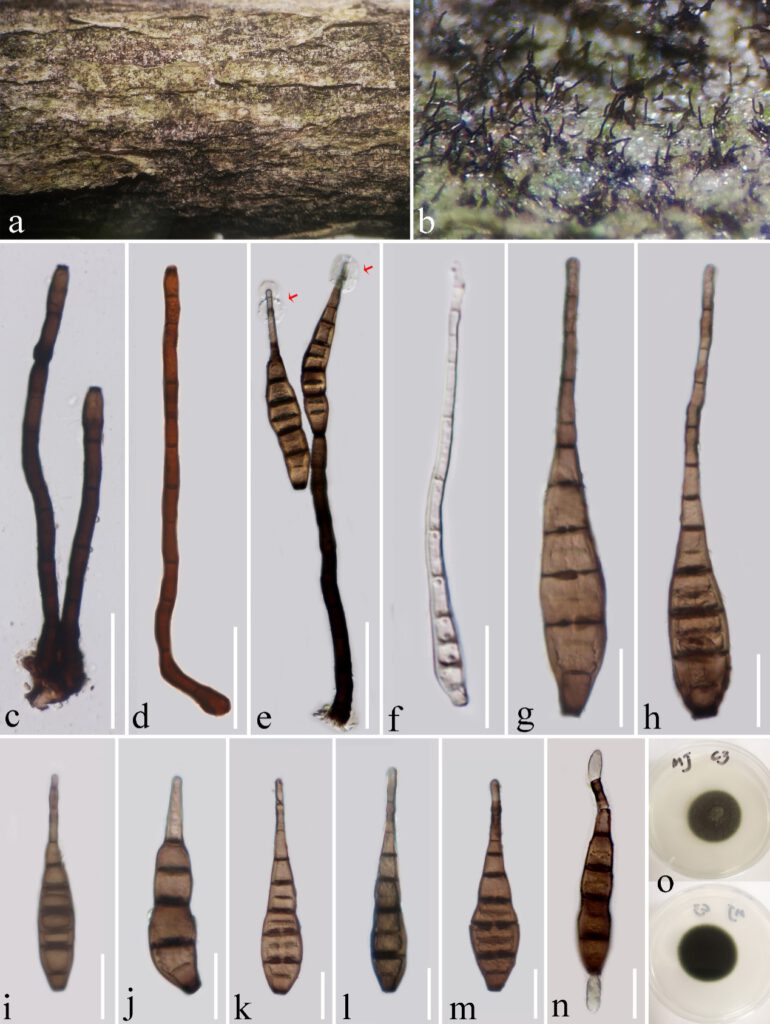Kirschsteiniothelia puerensis, L. Lu & Tibpromma, sp. nov.
MycoBank number: MB 559884; Index Fungorum number: IF 559884; Facesoffungi number: FoF 12893; Fig. x
Etymology: In reference to the host location, “Pu’er” city, where the holotype was collected.
Holotype: ZHKU 22-0142
Saprobic on decaying coffee wood. Sexual morph: Undetermined. Asexual morph: Colonies scattered on coffee wood, hairy, solitary or clustered, black, conspicuous on surface. Mycelium are exposed on the surface of the substrate except for the roots. Conidiophores 110–240 × 6–12 μm, (x̅ = 148.5 × 9 μm, n = 20), macronematous, mononematous, solitary or caespitose, cylindrical, straight or slightly flexuous, smooth, dark brown, unbranched, slightly swollen at the base, 7–15 septate. Conidiogenous cells 15–25 × 5–10 μm, (x̅ = 19 × 8 μm, n = 20) monoblastic, dark brown to black, terminal and smooth. Conidia 60–140 × 6–17 μm (x̅ = 98 × 14 μm, n = 20), acrogenous, solitary, obclavate, 5–12 septate, invagination in the septate, hyaline when immature and become pale-brown to brown, straight or curved, pale-brown at the apex, truncate at base, tapering towards apex, sometimes has long stipes up to 73 μm, some with a hyaline sheath around the tip (some two globose sheaths).
Culture characteristics: Conidia germinated within 12 hours on PDA. Colonies on PDA reaching 40 mm diam, after two months at room temperature (22 ℃). Circular, dark green, with aerial mycelium, dense and fluffy on the surface, sparse on the edge, black in reverse.
Material examined: China, Pu’er, Yunnan Province, on dead wood of coffea sp., 23 December 2020, li Lu, MJ-C3 (ZHKU 22-0142, holotype); ex-type living culture ZHKUCC 22-0271 = ZHKUCC 21-0272.
GenBank numbers: ITS = OP450977, LSU = OP451017, SSU = OP451020 (ZHKUCC 22-0271), ITS = OP450978, LSU = OP451018, SSU = OP451021 (ZHKUCC 22-0272).
Notes: In the phylogenetic tree, Kirschsteiniothelia puerensis formed a well-separated clade with modulates statistical support (50% ML/1.00 BYPP, Figure X), and clustering in a separate branch within Kir. thailandica (MFLUCC 20-0116) and Kir. xishuangbannaensis (ZHKUCC 22-0220). Based on the sequence blast results, ITS and SSU gene sequences were similar to Kir. thailandica, with 90% (MT985633) and 98% (MT984280) respectively. The LSU was similar to Kir. rostrata with 93.5% (NG_059790). In morphological, Kir. puerensis also has similar morphological features with Kir. rostrata, Kir. thailandica and Kir. xishuangbannaensis (Hyde et al. 2017, Sun et al. 2021, Fang et al. 2022). However, Kir. puerensis conidiophores (110–240 × 6–12 μm, 7–12 septate) are longer than Kir. thailandica (55–93 × 7–10 μm), but shorter than Kir. rostrata (190–450 × 9–15 μm, 7–24 septate), and the conidia of Kir. puerensis have two hyaline sheath around the tip, which can be distinguish with Kir. Xishuangbanaensis. In addition, Kir. puerensis conidia is 5–12 septate, while Kir. thailandica is 6–8-septate, Kir. rostrata 8–13-septate, and Kir. Xishuangbanaensis 3–8-septate (Hyde et al. 2017, Sun et al. 2021, Fang et al. 2022). Hence, based on both morphology and phylogeny, we introduce Kir. puerensis as a new species of Kirschsteiniothelia.

Fig. X Kirschsteiniothelia puerensis (ZHKU 22-0142). a, b Colonies on host. c, d Conidiophore, e Conidiophore with conidia and sheath. f-m Conidia. n Germinated conidium. o Culture on PDA from surface and reverse. Scale bars: c-e = 50 μm, f-n = 20 μm.
